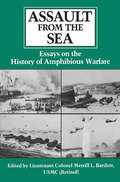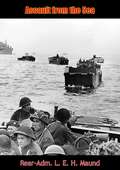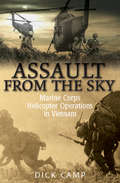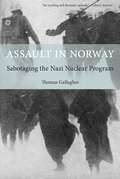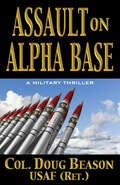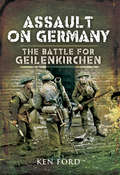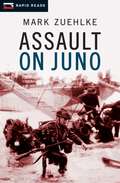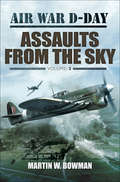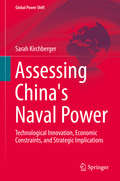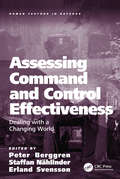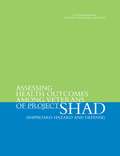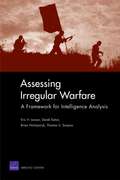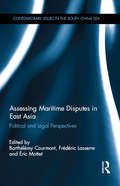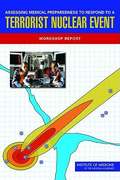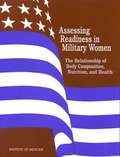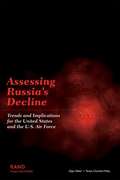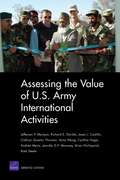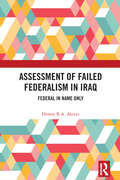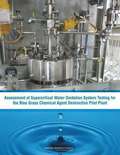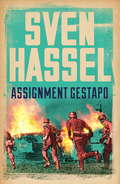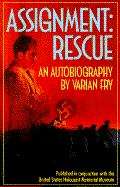- Table View
- List View
Assault from the Sea
by Merrill L. BartlettThis collection of 51 essays provides a history of amphibious landings that include European, Asian, and American operations. It describes in detail some of history's most significant amphibious assaults, as well as planned attacks that were never carried out.
Assault from the Sea
by Rear-Adm. L. E. H. MaundAssault from the Sea, first published in 1949, is Rear-Admiral Maund’s account of the development of the Royal Navy’s landing craft and their use operationally between 1939 and 1945.“It is the purpose of this book to show how this knowledge and equipment were gradually collected. It starts in the days before the last war, when most people thought landing operations would be impossible, and traces their development to the days of the great awakening at Dunkirk and on to present times. It shows how developments in material, tactics and planning were evolved by original thought, training, planning operations and experiments and it indicates the influence of political and strategic considerations upon this development.”—Preface
Assault from the Sky: Marine Corps Helicopter Operations in Vietnam
by Dick Camp&“Action-packed . . . he brings the reader artfully through the fog of war with clarity&” (20th Century Aviation Magazine). Vietnam has often been called our &“first helicopter war,&” and indeed, the US Marine Corps, as well as Army, had to feel its way forward during the initial combats. But by 1967, the combat was raging across South Vietnam, with confrontational battles against the NVA on a scale comparable to the great campaigns of WWII. In 1968, when the Communists launched their mammoth counteroffensive, the Marines were forced to fight on all sides, with the helicopter giving them the additional dimension that proved decisive in repelling the enemy. The author of this book, a Vietnam veteran and Purple Heart recipient who has also worked at the USMC History Division and National Museum of the Marine Corps in Quantico, uses his experiences as a company commander to bring the story to life by weaving personal accounts, after-action reports, and official documents into a compellingly readable narrative of service and sacrifice by Marine pilots and crewmen. The entire story of the war is depicted through the prism of Marine helicopter operations, from the first deployments to support the Army of the Republic of Vietnam against the Viet Cong through the rapid US buildup to stop the North Vietnamese Army, until the final withdrawal from our Embassy. &“Superlative research.&” —Leatherneck
Assault in Norway: Sabotaging The Nazi Nuclear Program
by Thomas Gallagher&“An exciting and dramatic episode.&”—Library Journal&“Cliff-hanging suspense.&”—Christian Science Monitor Assault in Norway is the classic account of a legendary raid on the Nazi war program. By 1942 Germany had a seemingly insurmountable lead over the Allies in developing an atomic bomb. Contributing to this situation was its access to a crucial ingredient: &“heavy water,&” found in great abundance at a fortresslike factory in occupied Norway. Allied hopes of stalling the Nazi nuclear program soon focused on sabotaging the cliffside plant—a suicidal mission. But a team of brave Norwegian exiles, trained in Britain, infiltrated their homeland and, hiding in the wilds, awaited the opportunity to launch one of the war&’s most daring commando raids. Basing his gripping narrative in large part on interviews with the commandos themselves, Thomas Gallagher recounts in vivid detail the planning and execution of Operation Gunnerside. Assault in Norway recalls the intrigue found in such wartime classics as David Howarth&’s We Die Alone and The Sledge Patrol, and the mission it recounts inspired the 1965 Hollywood film The Heroes of Telemark.
Assault on Alpha Base
by Doug BeasonA US Air Force commander fights to take back his base and stop terrorists from unleashing a nuclear attack in this gripping thriller. The greatest power on Earth is about to be stripped of its defenses Alpha Base. It&’s the home of America&’s nuclear stockpile, over 5,000 warheads protected by a formidable high-tech security system deep in the salt flats of Nevada. If Alpha Base is ever penetrated, no one on earth will be safe . . . From the heart of remote Africa, a terrorist army has launched a daring plot. Their objective: seize Alpha and steal its deadly cache of superweapons. Their allies: American scientist Dr. Anthony Harding and his lover Vikki Osborrn, self-styled revolutionaries who&’ll blast a pathway to the base from its own backyard. Their adversary: Major William McGriffin, USAF; acting commander of the base. Cut off from his command post, McGriffin must implement a surgically precise counterstrike to retake Alpha-knowing that if he makes one mistake, the entire world will pay . . . Praise for Assault on Alpha Base&“So real, so disturbing . . . Will easily double your heart rate.&” —M. E. Morris, author of The Icemen
Assault on Germany: The Battle for Geilenkirchen
by Ken FordThe author of A Luftwaffe General gives a detailed history of the Allied forces&’ brutal Operation Clipper during World War II. The Anglo-American battle for the Geilenkirchen salient in November, 1944, was infantry warfare at its worst, and it is described in vivid detail in this new edition of Ken Ford&’s classic study. The onset of winter saw the Allied advance from the Normandy beaches forced to a halt on Germany&’s doorstep. The clock had been put back to the days of the Great War—the Allies had arrived at the Siegfried Line and were forced to attack the fortifications from the hell of the trenches. Geilenkirchen was the first battle on German soil to be fought by the British since Minden in 1759. For them, it was just one more battle on the way to Berlin, but for the American 84th Division, it was a first faltering step into war and a bitter lesson in the attrition and savagery of combat. The story is told by the men who were there—the British, the Americans, and the Germans who were fighting desperately for their homeland. Neither side was victorious—both lost more men than they could afford and paid a heavy price in young lives for a few miles of ground.
Assault on Juno (Rapid Reads)
by Mark ZuehlkeDawn, June 6, 1944. Off the Normandy coast 6,500 ships carry 150,000 Allied troops. This is D-Day, the long-awaited Allied invasion of German-occupied Europe. The Allies will storm five beaches. One is code-named Juno Beach. Here, 14,500 Canadians will land on a five-mile stretch of sand backed by three resort towns. The beach is heavily protected by a seawall, barbed wire, underwater obstacles and hundreds of mines. Behind these defenses a heavily armed German force waits inside thick concrete pillboxes and deep trenches that bristle with machineguns and artillery pieces. About 3,500 Canadians will lead the way. The fate of the invasion is in their hands. They either break the German defenses or die trying. Piling out of small, frail landing craft, they struggle through bullet- and shell-whipped water to gain the sand. And the bloody battle for Juno Beach begins. With his trademark you-are-there style, acclaimed military historian Mark Zuehlke plunges readers into a vivid and powerful account of the day-long battle that put the Allies on the march toward victory in World War II.
Assaults from the Sky: Assaults From The Sky (Air War D-Day #2)
by Martin W. BowmanThis is the second volume of a comprehensive five part work on D-Day that includes a multitude of personal military accounts from both Allied and German Aviation personnel who were there. Overlord began with an assault by more than 23,000 airborne troops, 15,500 of them American, behind enemy lines to soften up the German troops and to secure key objectives. 6,600 paratroopers of the US 101st Screaming Eagles Division in 633 C-47s and 83 gliders and 6,396 paratroopers of the US 82nd All American Division in 1,101 C-47s and 427 gliders were dropped over the neck of the Cotentin peninsula. By the end of the operation, the list of casualties was extensive. But 101st Airborne Division linked up with the US 4th Infantry Division beach landings at Pouppeville, the most southerly exit off Utah Beach and the 82nd secured the area north of Ste-Mre-glise after fierce fighting and drove the enemy north, considerably delaying the German 243rd Infantry Division from contacting the Allied beach assault force. This important episode within the wider history of D-Day is enlivened in classic Bowman fashion, featuring both extensive historical notes as well as deeply personal accounts of endurance and individual gallantry.
Assessing China's Naval Power: Technological Innovation, Economic Constraints, and Strategic Implications (Global Power Shift)
by Sarah KirchbergerThis book analyzes the rise of China's naval power and its possible strategic consequences from a wide variety of perspectives - technological, economic, and geostrategic - while employing a historical-comparative approach throughout. Since naval development requires huge financial resources and mostly takes place within the context of transnational industrial partnerships, this study also consciously adopts an industry perspective. The systemic problems involved in warship production and the associated material, financial, technological, and political requirements currently remain overlooked aspects in the case of China. Drawing on first-hand working experience in the naval shipbuilding industry, the author provides transparent criteria for the evaluation of different naval technologies' strategic value, which other researchers can draw upon as a basis for further research in such diverse fields as International Security Studies, Naval Warfare Studies, Chinese Studies, and International Relations.
Assessing Command and Control Effectiveness: Dealing with a Changing World (Human Factors in Defence)
by Peter Berggren Staffan Nählinder Erland SvenssonAssessing Command and Control Effectiveness: Dealing with a Changing World offers a description of the current state of Command and Control (C2) research in imperfect settings, showing how a research process should assess, analyse and communicate results to the development cycle of methods, work, manning and C2-technology. Special attention is given to the development of C2 research methods to meet the current and coming needs. The authors also look forward towards a future where effective assessment of C2 abilities are even more crucial, for instance in agile organisations. The purpose of the C2 research is to improve the process and make it more effective while still saving time and money. Research methods have to be chosen carefully to be effective and simple, yet provide results of high quality. The methodological concerns are a major consideration when working under such circumstances. Furthermore, there is often a need for a swift iterative development cycle, and thus a demand to quickly deliver results from the research process. This book explains how field research experimentation can be quick, simple and effective, being able to draw valid conclusions even when sample sizes are small and resources are limited, collecting empirical data using measures and procedures that are minimally intrusive.
Assessing Health Outcomes Among Veterans of Project SHAD (Shipboard Hazard and Defense)
by Engineering Medicine National Academies of SciencesBetween 1963 and 1969, the U.S. military carried out a series of tests, termed Project SHAD (Shipboard Hazard and Defense), to evaluate the vulnerabilities of U.S. Navy ships to chemical and biological warfare agents. These tests involved use of active chemical and biological agents, stimulants, tracers, and decontaminants. Approximately 5,900 military personnel, primarily from the Navy and Marine Corps, are reported to have been included in Project SHAD testing. In the 1990s some veterans who participated in the SHAD tests expressed concerns to the Department of Veterans Affairs (VA) that they were experiencing health problems that might be the result of exposures in the testing. These concerns led to a 2002 request from VA to the Institute of Medicine (IOM) to carry out an epidemiological study of the health of SHAD veterans and a comparison population of veterans who had served on similar ships or in similar units during the same time period. In response to continuing concerns, Congress in 2010 requested an additional IOM study. This second study expands on the previous IOM work by making use of additional years of follow up and some analysis of diagnostic data from Medicare and the VA health care system.
Assessing Irregular Warfare
by Eric V. Larson Brian Nichiporuk Derek Eaton Thomas S. SzaynaProvides an analytic framework and procedure for the intelligence analysis of irregular warfare (IW) environments that can serve as the basis for IW intelligence curriculum development efforts. Defines IW in terms of two stylized situations: population-centric (such as counterinsurgency) and counterterrorism. Provides a detailed review of IW-relevant defense policy and strategy documents and a list of relevant doctrinal publications.
Assessing Maritime Disputes in East Asia: Political and Legal Perspectives (Contemporary Issues in the South China Sea)
by Barthélémy Courmont, Frédéric Lasserre and Éric MottetCombining practical and theoretical approaches, this book addresses the political, legal and economic implications of maritime disputes in East Asia. The maritime disputes in East Asia have multiplied over the past few years, in parallel with the economic growth of the countries in the region, the rise of nationalist movements, fears and sometimes fantasies regarding the emergence of the People’s Republic of China (PRC) as a global power, increasing military expenses, as well as speculations regarding the potential resources in various disputed islands. These disputes, however, are not new and some have been the subject of contention and the cause of friction for decades, if not centuries in a few cases. Offering a robust analysis, this volume explores disputes through the different lenses of political science, international law, history and geography, and introduces new approaches in particular to the four important disputes concerning Dokdo/Takeshima, Senkaku/Diaoyu, Paracels and Spratlys. Utilising a comparative approach, this book identifies transnational trends that occur in the different cases and, therefore, at the regional level, and aims to understand whether the resurgence of maritime disputes in East Asia may be studied on a case by case basis, or should be analysed as a regional phenomenon with common characteristics. This book will be of interest to students of Asian Politics, Maritime Security, International Security, Geopolitics and International Relations in general.
Assessing Medical Preparedness to Respond to a Terrorist Nuclear Event: Workshop Report
by Institute of MedicineA nuclear attack on a large U.S. city by terrorists--even with a low-yield improvised nuclear device (IND) of 10 kilotons or less--would cause a large number of deaths and severe injuries. The large number of injured from the detonation and radioactive fallout that would follow would be overwhelming for local emergency response and health care systems to rescue and treat, even assuming that these systems and their personnel were not themselves incapacitated by the event. The United States has been struggling for some time to address and plan for the threat of nuclear terrorism and other weapons of mass destruction that terrorists might obtain and use. The Department of Homeland Security recently contracted with the Institute of Medicine to hold a workshop, summarized in this volume, to assess medical preparedness for a nuclear detonation of up to 10 kilotons. This book provides a candid and sobering look at our current state of preparedness for an IND, and identifies several key areas in which we might begin to focus our national efforts in a way that will improve the overall level of preparedness.
Assessing Readiness in Military Women: The Relationship of Body Composition, Nutrition, and Health
by Committee on Body Composition Nutrition Health of Military WomenU.S. military personnel are required to adhere to standards of body composition, fitness, and appearance to achieve and maintain readiness--that is, the maintenance of optimum health and performance so they are ready for deployment at any moment. In 1992, the Committee on Military Nutrition Research reviewed the existing standards and found, among other things, that the standards for body composition required for women to achieve an appearance goal seemed to conflict with those necessary to ensure the ability to perform many types of military tasks. This report addresses that conflict, and reviews and makes recommendations about current policies governing body composition and fitness, as well as postpartum return-to-duty standards, Military Recommended Dietary Allowances, and physical activity and nutritional practices of military women to determine their individual and collective impact on the health, fitness, and readiness of active-duty women.
Assessing Russia's Decline: Trends and Implications for the United States and the U. S. Air Force
by Olga Oliker Tanya Charlick-PaleyWhat challenges does today's Russia pose for the United States and the U.S. Air Force? If certain economic, military, social, and political negative trends in Russia continue, they may create a new set of dangers that might prove more real, and therefore more frightening, than the far-off specter of Russian attack ever was. In a number of scenarios, the U.S. Air Force is certain to be called upon for transportation and perhaps for various military missions in a very demanding environment.
Assessing the Implications of Allowing Transgender Personnel to Serve Openly
by Agnes Gereben Schaefer Jennifer Kavanagh Kayla M. Williams Srikanth Kadiyala Radha Iyengar Amii M. Kress Charles C. EngelThe U.S. Department of Defense is considering a change in policy to allow transgender military personnel to serve openly. A RAND study examined the health care needs of transgender personnel, the costs of gender transition-related care, and the potential readiness implications of a policy change. The experiences of foreign militaries that permit transgender service members to serve openly also point to some best practices for U.S. policymakers.
Assessing the Value of U.S. Army International Activities
by Anny Wong Jefferson P. Marquis Cathryn Quantic Thurston Jasen J. Castillo Richard E. DarilekThis report presents a framework for assessing U.S. Army International Activities (AIA). It also provides a matrix of eight AIA "ends," derived from top-level national and Army guidance, and eight AIA "ways," which summarize the various capabilities inherent in AIA programs. In addition, the report describes the new online AIA Knowledge Sharing System (AIAKSS) that is being used to solicit programmatic and assessment data from AIA officials in the Army's Major Commands.
Assessment of Agent Monitoring Strategies for the Blue Grass and Pueblo Chemical Agent Destruction Pilot Plants
by Committee on Assessment of Agent Monitoring Strategies for the Blue Grass Pueblo Chemical Agent Destruction Pilot PlantsJanuary 2012 saw the completion of the U. S. Army's Chemical Materials Agency's (CMA's) task to destroy 90 percent of the nation's stockpile of chemical weapons. CMA completed destruction of the chemical agents and associated weapons deployed overseas, which were transported to Johnston Atoll, southwest of Hawaii, and demilitarized there. The remaining 10 percent of the nation's chemical weapons stockpile is stored at two continental U. S. depots, in Lexington, Kentucky, and Pueblo, Colorado. Their destruction has been assigned to a separate U. S. Army organization, the Assembled Chemical Weapons Alternatives (ACWA) Element. ACWA is currently constructing the last two chemical weapons disposal facilities, the Pueblo and Blue Grass Chemical Agent Destruction Pilot Plants (denoted PCAPP and BGCAPP), with weapons destruction activities scheduled to start in 2015 and 2020, respectively. ACWA is charged with destroying the mustard agent stockpile at Pueblo and the nerve and mustard agent stockpile at Blue Grass without using the multiple incinerators and furnaces used at the five CMA demilitarization plants that dealt with assembled chemical weapons - munitions containing both chemical agents and explosive/propulsive components. The two ACWA demilitarization facilities are congressionally mandated to employ noncombustion-based chemical neutralization processes to destroy chemical agents. In order to safely operate its disposal plants, CMA developed methods and procedures to monitor chemical agent contamination of both secondary waste materials and plant structural components. ACWA currently plans to adopt these methods and procedures for use at these facilities. The Assessment of Agent Monitoring Strategies for the Blue Grass and Pueblo Chemical Agent Destruction Pilot Plants report also develops and describes a half-dozen scenarios involving prospective ACWA secondary waste characterization, process equipment maintenance and changeover activities, and closure agent decontamination challenges, where direct, real-time agent contamination measurements on surfaces or in porous bulk materials might allow more efficient and possibly safer operations if suitable analytical technology is available and affordable.
Assessment of Failed Federalism in Iraq: Federal in Name Only
by Hemin R.A. AkreyiAkreyi investigates the development of federal relations in Iraq from the adoption of the new Federal Constitution in 2005 to the Kurdistan independence referendum in 2017.The book highlights the dysfunctionality of the Iraqi federal system even after the independence referendum and shows the true picture of the key issues between the Kurdistan Region and the Iraqi government in Baghdad. This informative content is presented in an easy-to-grasp manner, originating primarily from face-to-face interviews with relevant elites and decision-makers in Iraq as well as foreign diplomats.A valuable source for academics, researchers, journalists, and students of politics and international relations at the undergraduate and postgraduate levels in all universities, especially in the West and Middle East.
Assessment of Supercritical Water Oxidation System Testing for the Blue Grass Chemical Agent Destruction Pilot Plant
by National Research Council Board on Army Science and Technology Division on Engineering and Physical Sciences Committee to Assess Supercritical Water Oxidation System Testing for the Blue Grass Chemical Agent Destruction Pilot PlantAssessment of Supercritical Water Oxidation System Testing for the Blue Grass Chemical Agent Destruction Pilot Plant reviews and evaluates the results of the tests conducted on one of the SCWO units to be provided to Blue Grass Chemical Agent Destruction Pilot Plant. The Army Element, Assembled Chemical Weapons Alternatives (ACWA) is responsible for managing the conduct of destruction operations for the remaining 10 percent of the nation's chemical agent stockpile, stored at the Blue Grass Army Depot (Kentucky) and the Pueblo Chemical Depot (Colorado). Facilities to destroy the agents and their associated munitions are currently being constructed at these sites. The Blue Grass Chemical Agent Destruction Pilot Plant (BGCAPP) will destroy chemical agent and some associated energetic materials by a process of chemical neutralization known as hydrolysis. The resulting chemical waste stream is known as hydrolysate. Among the first-of-a-kind equipment to be installed at BGCAPP are three supercritical water oxidation (SCWO) reactor systems. These particular hydrolysate feeds present unique non-agent-related challenges to subsequent processing via SCWO due to their caustic nature and issues of salt management.This report provides recommendations on SCWO systemization testing inclusive of durability testing and discusses systemization testing objectives and concepts.
Assessment of the AHRQ Patient Safety Initiative
by Michael D. Greenberg Cheryl L. Damberg Donna O. Farley Melony E. Sorbero M. Susan RidgelyUpdates the policy context of the Agency for Healthcare Research and Quality (AHRQ) patient safety initiative; documents the current priorities and activities undertaken; and assesses contributions of health information technology projects and dissemination actions to support adoption of evidence-based safe practices. Discusses implications for future AHRQ policy, programming, and research; suggests ways to strengthen AHRQ activities.
Assignment Gestapo
by Sven HasselA sobering portrait of the absurdity of the Nazi regime and the atrocities committed by Hitler's secret police.'Frighteningly vivid, a most strongly felt piece of writing' IRISH TIMESAfter months of fighting a savage war on the Eastern Front, the 27th Penal Regiment - men considered little more than criminals - are joined by German reserves.A garrison has been attacked and occupied by Russian troops. The German soldiers have been slaughtered. Sven Hassel and his comrades are ordered to get behind Russian lines and massacre those responsible. But this is only the beginning... Because then the orders change: the regiment are sent to Hamburg, where their next assignment is guard duty for the mercilessly cruel Gestapo...
Assignment Gestapo (Sven Hassel War Classics)
by Sven HasselA sobering portrait of the absurdity of the Nazi regime and the atrocities committed by Hitler's secret police.'Frighteningly vivid, a most strongly felt piece of writing' IRISH TIMESAfter months of fighting a savage war on the Eastern Front, the 27th Penal Regiment - men considered little more than criminals - are joined by German reserves.A garrison has been attacked and occupied by Russian troops. The German soldiers have been slaughtered. Sven Hassel and his comrades are ordered to get behind Russian lines and massacre those responsible. But this is only the beginning... Because then the orders change: the regiment are sent to Hamburg, where their next assignment is guard duty for the mercilessly cruel Gestapo...
Assignment Rescue: An Autobiography
by Varian FryThe Gestapo's blacklist was thousands of names long.... How many people could he get out before Hitler sealed the frontiers? Varian Fry didn't know any more about being an undercover agent than what he'd seen in the movies. But he was the one man who could get into Vichy France, where thousands of people had fled Hitler's Germany. Unless he could get them out, they'd be trapped--turned back to the concentration camps and death camps. An exciting, true story of World War II--Varian Fry describes the methods he used to get thousands of hunted men and women to safety.
